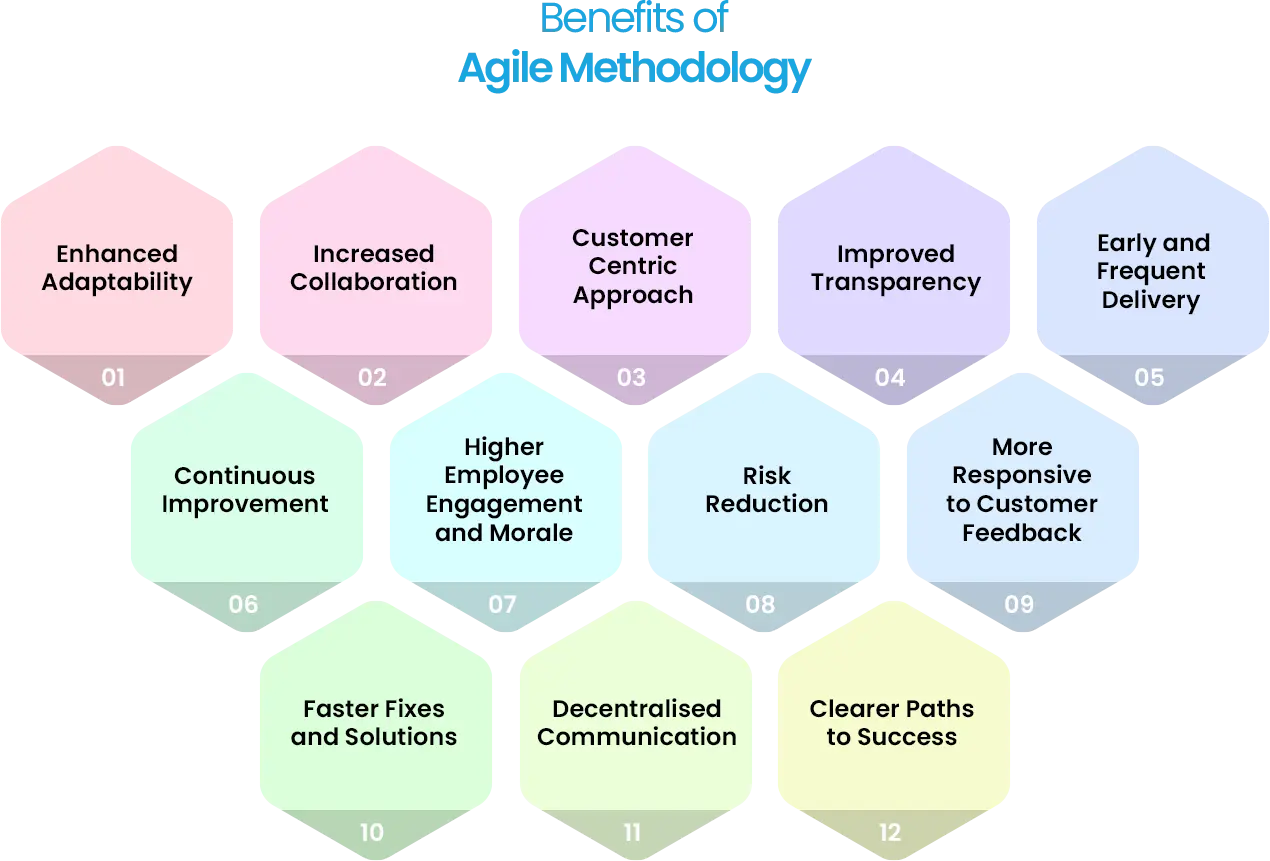In today’s fast-paced business world, things change quickly, and organisations need ways to stay flexible, efficient and continuous improvement. That’s where Agile comes in. Agile methodology in project management is a popular and effective way to manage projects, helping teams adapt and succeed.
By embracing the core principles of Agile, businesses can unlock a host of benefits that enhance productivity, stakeholder satisfaction, and overall project success. Let’s delve into the 12 key benefits of Agile methodology, along with some essential tools and best practices.

1. Enhanced Adaptability
Agile methodology embraces change as an inherent part of the development process. Unlike traditional linear approaches, Agile allows teams to respond quickly and effectively to changes in requirements, market trends, and customer feedback.
Tools
Tools such as Scrum and Kanban boards help teams visualise tasks, prioritise work, and track progress dynamically. Agile project management tools like Jira, Trello, or Asana support backlog management, sprint planning, and team collaboration, ensuring seamless adaptability throughout the project lifecycle.
Best Practice
Conduct regular sprint planning meetings to prioritise work for each iteration. Maintain a well-groomed product backlog for clear visibility and continuous refinement of requirements.
2. Increased Collaboration
Agile promotes teamwork and collaboration by encouraging people from different areas of expertise to work together towards a shared objective.
“Alone we can do so little; together we can do so much.” – Helen Keller. (Source: VMMissions).
Tools
Collaboration tools like Slack, Microsoft Teams, or Zoom facilitate real-time communication and seamless teamwork, regardless of location. Virtual whiteboarding tools, such as Miro or Mural, help teams brainstorm, visualise ideas, and collectively solve problems.
Best Practice
Encourage daily stand-up meetings to foster open communication, share progress updates, and identify potential roadblocks. Create a culture of trust where team members feel comfortable sharing their opinions and ideas.
3. Customer-Centric Approach
Customer satisfaction is at the core of Agile methodology. Agile teams actively engage with customers, ensuring the final product meets their needs and expectations.
Tools
Techniques like user story mapping and personas help teams understand customer perspectives, while tools such as User Testing or UserVoice gather real-time feedback. Iterative development allows for continuous improvements based on user insights.
Best Practice
Involve customers or product owners in sprint reviews and incorporate their feedback into future iterations. Implement a feedback loop to continuously refine the product.
4. Improved Transparency
Transparency is a vital aspect of Agile, enabling stakeholders to have clear visibility into project progress. Through daily stand-up meetings, sprint reviews, and task boards, Agile teams provide real-time updates.
Tools
Project management tools like Azure DevOps, Monday.com, or ClickUp offer dashboards and reporting features that help track progress, monitor key metrics, and ensure alignment with business objectives.
Best Practice
Maintain an up-to-date Kanban board to visualise work and foster transparency. Regularly share project status reports or burndown charts with stakeholders to build trust and alignment.
5. Early and Frequent Delivery
Agile project management is all about delivering real value and showing results quickly and consistently throughout the project lifecycle. By breaking projects down into smaller chunks (sprints), teams can regularly release working parts of the product.
Tools
Continuous integration and deployment tools like Jenkins, CircleCI, or GitLab automate testing and deployment, ensuring rapid delivery of functional software.
Best Practice
Focus on small, releasable increments within each sprint to receive early feedback and validation. Implement automated testing and continuous integration pipelines for faster, more reliable deployments.
6. Continuous Improvement
Agile methodology fosters a culture of continuous improvement. At the end of each sprint, reexamination meetings allow teams to reflect on their performance, identify areas for enhancement, and implement changes accordingly.
Tools
Tools like Retrium, FunRetro, or Miro’s retrospective templates facilitate structured retrospectives, enabling teams to capture insights and drive ongoing enhancements.
Best Practice
Encourage a blame-free environment during reexamination, where team members feel safe to propose process improvements. Document action items and track their implementation.
Continuous improvement is a key Agile principle. Teams that invest in learning Agile best practices stay ahead of the curve. Check out our programs.
7. Higher Employee Engagement and Morale
Agile empowers teams by promoting autonomy, ownership, and accountability, leading to increased job satisfaction and engagement.
Tools
Self-organising teams have the flexibility to make decisions, set priorities, and collaborate efficiently. To boost this, utilise tools like Bonusl, and 15Five. The iterative and interactive nature of Agile keeps work dynamic and prevents burnout.
Best Practice
Encourage team empowerment by involving members in decision-making and problem-solving. Recognise achievements and celebrate milestones to maintain motivation and morale.
8. Risk Reduction
Agile’s approach helps find and fix problems early on. By delivering frequent updates, the team can address potential issues before they become major problems.
Tools
Regular feedback loops, continuous testing, and early defect detection ensure that Agile projects maintain high quality and stability. For this, use tools like SonarQube for code quality analysis, Selenium for automated testing, and Snyk for security scans
Best Practice
Conduct risk assessments at the beginning of each sprint to proactively address potential challenges. Implement automated testing to catch defects early and reduce long-term risks.
9. More Responsive to Customer Feedback
With Agile, teams can incorporate customer feedback at every stage of development. This ensures the final product aligns closely with user expectations, reducing the risk of costly post-launch changes.
“Feedback is the breakfast of champions.” – Ken Blanchard. (Source: Ken Blanchard Books).
Tools
User feedback platforms, surveys, and direct communication channels. Tools like UserVoice for feature requests, SurveyMonkey and Typeform for surveys can be very helpful.
Best Practice
Establish regular feedback loops with customers, and incorporate user stories and reviews into each sprint.
10. Faster Fixes and Solutions
Agile uses short development cycles so teams can find and fix problems quickly. This means that problems get sorted before they get worse, which in turn makes a better and user-friendly product
Tools
Bug tracking software, and automated testing tools. Use tools like Jira or Bugzilla for bug tracking, and JUnit/NUnit for unit testing.
Best Practice
Implement rapid repetition cycles, and prioritise bug fixes within each sprint.
11. Decentralised Communication
Agile cuts through the bureaucracy and lets the team talk directly to each other. This means quicker decisions and a smoother workflow, which makes everything more efficient.
Tools
Instant messaging platforms, and video conferencing tools. Use tools like Slack or Microsoft Teams for messaging, and Zoom, Google Meet, or Discord for video conferencing.
Best Practice
Encourage direct communication and collaboration among team members.
12. Clearer Paths to Success
Agile helps projects stay on track by making steady progress and always finding ways to improve. The team regularly checks in on how things are going, which helps them get better results over time.
Tools
Project tracking tools and retrospection platforms. Tools like Jira or Azure DevOps for sprint tracking, Retrium or EasyRetro for retrospectives, and Miro or Mural for visual collaboration will be very helpful.
Best Practice
Implement regular retrospectives and use the results to improve future sprints.
Conclusion
Embracing Agile brings numerous benefits to organisations seeking efficient and adaptable project management practices. By leveraging essential tools and following best practices, teams can fully capitalise on the advantages of Agile methodology.
Through the advantages of agile methodology, organisations can successfully navigate complex projects, exceed stakeholder expectations, and thrive in today’s dynamic business landscape.
Consider enrolling with TechForce Academy to have access to various IT and Salesforce-related courses.











